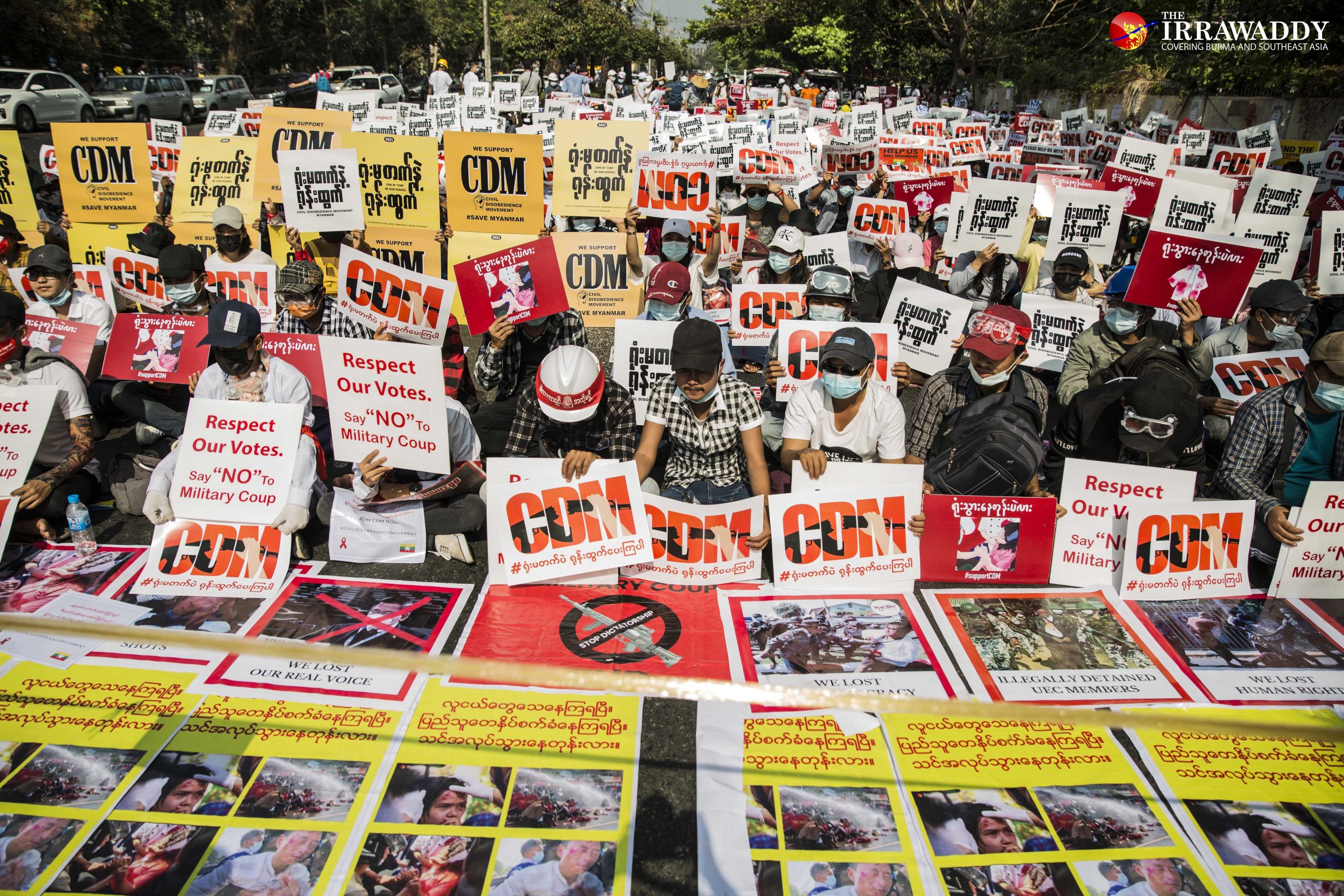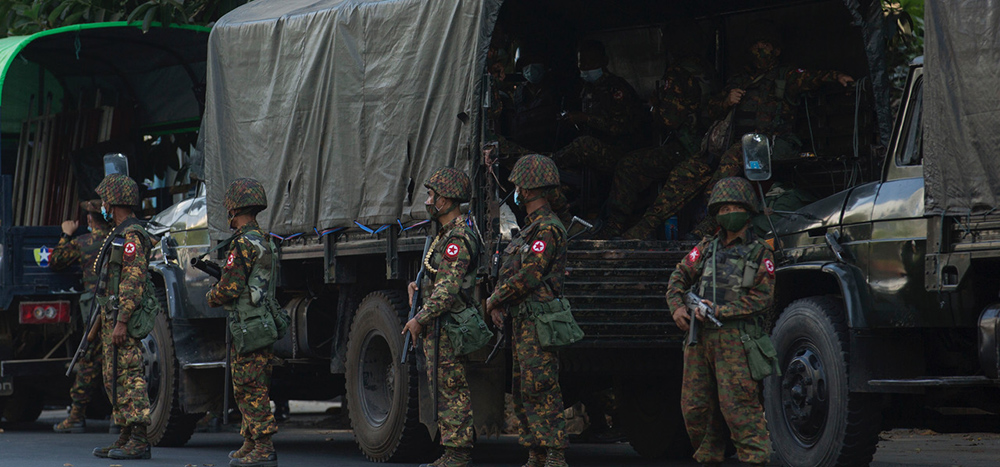In the following interview, human rights campaigner Igor Blazevic asks security analyst Anthony Davis about the state of the civil and armed opposition to the junta, and the condition of the Myanmar military after two years of trying to contain the armed uprising.
Blazevic: Anthony, you are military analyst, but let me start by asking, are multiple forms of civil resistance and disobedience still important factors in Myanmar’s anti-junta uprising? Spring Revolution started with the civil resistance and only later it transformed into the armed resistance as well. What role the civic resistance plays now? Is it still very important factor or the outcome will be decided on the battlefield?
Davis: Civilian mobilization and civic organization is fundamental in underpinning support for any popular armed struggle. This is particularly important in a situation where there is no revolutionary party as an organizing core which is very much the case in Myanmar today: the NLD represented the legitimacy underpinning the popular uprising of 2021 but it is certainly not a revolutionary party going forward. So, if you don’t have that one revolutionary center then civic organizations across the country in different regions become critically important. You can’t have a people’s war without people’s participation, politically, economically, militarily, in terms of the information war — across the whole spectrum. Although the military struggle, in my opinion, will be the decisive element, without the continued support and participation of society through civil organizations, including those supported by the NUG, that military element cannot hope to prevail.

Blazevic: We are already second year of a conflict that is extremely exhausting conflict for the population. Do you see popular support for the revolution and resistance already floundering under the pressure of the military atrocities or you think the resilience of the people of Myanmar is still as strong as it was at the beginning of the uprising?
Davis: That’s a difficult question for me to answer sitting in a comfortable office in Bangkok. But my general impression is that the people of Myanmar are still very much committed to the struggle. They recognize that this is a revolutionary opportunity, which is probably not going to come again – a truly historic opportunity to introduce a new political, social and economic system for Myanmar. I think that awareness is generally felt.
However, there will obviously be areas where the degree of support or of exhaustion varies. What I am hearing is that, if you’re in an urban area of Myanmar, if you’re in Yangon, Mandalay or one of the big cities, life for many people is to a degree normal. I was talking to somebody the other day who just arrived from Yangon and this lady was saying, “I’m not seeing troops on the streets, I do not have to go through checkpoints. Life is largely normal”. So, if you are in an urban area without much disruption, it is reasonable to assume you will want to get back to a normal life, being able to feed your family and do your business as soon as possible.
However, if you are in an area where the war is immediate and real, in Karen state or in Sagaing or Magway or Chin where the fighting is ongoing, where villages are being destroyed, where people are being killed, then I would imagine that there is a very powerful level of anger driving participation. It would depend very much on where you are.
Blazevic: Is Myanmar military being significantly weakened? They are losing soldiers and territory, they face defections, they have recruitment problems. Is Myanmar military still strong enough for a war of attrition? What currently are the main vulnerabilities on Myanmar military?
Davis: From the beginning of the crisis, I have always argued that it would be a very serious mistake to underestimate the strength of the Myanmar military. This is a huge organization which for seven decades has been used not just to running the country but also coming to feel that they own the country — that they somehow represent the essence of Myanmar and have the right to decide what is the best for it and how politics will be played. With this mentality the military has built up over time a very significant degree of organization, internal cohesion, discipline, military resources, and economic power. It would be a bad mistake to underestimate these people simply because the ordinary people of Myanmar have stood up to fight them. They should not be underestimated.
There has been a tendency since the months following the coup to exaggerate the number of defections and desertions from the military as well as their battlefield losses. The media, both in Myanmar and abroad have not done a very good job in looking at this issue of defections, desertions, losses in a realistic manner.
Let’s start with defections and desertions we hear so much about. Because we want to believe it, it’s tempting to think that this is an army on the verge of disintegration. This is clearly not the case. I have looked at the issue closely and talked to well-placed sources inside Myanmar regularly. My assessment, which may of course be wrong, is that desertions and defections may perhaps have totaled somewhere around 3,000, maybe 4,000, from the army and police over two years. In terms of battlefield losses, killed and badly wounded, my best estimate would be somewhere between 10,000 and 15,000 in two years.
So in terms of men who’ve quit the security forces plus those killed or wounded, we’re likely talking less than 20,000. Now this is a military which in terms of combat-capable units numbers somewhere over 100,000 personnel. You can then add to that an essentially militarized police force of not less than 70,000. So in terms of losses, perhaps 15,000 in two years from a military organization that is at least 170,000 strong, maybe more. These are not insignificant losses but they’re certainly not crippling, and I doubt if they are going to produce any dramatic reassessment of how the military looks at this struggle. I would argue that such losses are seen from Naypyidaw as acceptable; that the military believes it can continue to function and fight with this level of loss.

Let me add one other thing as regards defections and desertions. They have almost all been defections of individuals or very small groups of two or three men leaving a unit. What we have not yet seen — and I stress the word ‘yet’ — is an entire unit of 10, 20, 30 men quitting en masse — either by giving up their weapons and going home or joining the resistance. That hasn’t happened. I believe that eventually it may happen but so far it has not, and we need to understand this. It is not a coincidence; it reflects the fact that the Myanmar military is a remarkably disciplined and cohesive organization.
So, if that’s the bad news, is there any good news? Yes: they also have some real weaknesses to contend with. The most fundamental is that they simply do not have enough manpower to suppress resistance across much of Myanmar. Almost every combat unit in Myanmar is undermanned, and overall, the military is overstretched. It’s trying to do too much in too many places. A battalion in the Myanmar army should number around 750 men, officers and other ranks. A typical battalion now today in Myanmar is probably 200 on a very good day, often 150 or less. Not 750, but 150 or less. This is a huge problem.
Air power can only offset this dilemma to a certain extent. And since the last quarter of 2022 there has been a lot of stress, in the media, from the NUG, from PDFs, from civil society, on the impact of air strikes and the fact that the resistance has no anti-aircraft capability. However, I would argue that it’s important not to exaggerate airpower and to understand its limitations. Having spent much of the 1980s working in Afghanistan where Soviet airpower was deployed against village-based guerrilla resistance in much the same way as across Myanmar today, I know a little bit about this. Then it was Mi-24 helicopter gunships and Su-25 ground attack jets; now it’s Mi-24s and YAK-130 jets. These strikes can certainly cause large scale displacement of the civil population. But guerrilla resistance learns to adapt to the threat using camouflage, dispersal and optimum timing for their own attacks. So in a guerrilla environment, the initial psychological and kinetic shock of air power typically diminishes over time.
Where air power can of course be incredibly destructive, both physically and in terms of morale, is when guerrilla forces allow themselves to get bogged down in protracted assaults against army strongpoints or futile attempts to capture urban areas. At this stage in the war the regime in Naypyidaw will absolutely not accept the loss of urban areas. They will destroy them in order to “save” them, killing not only resistance fighters but also their civilian supporters. That will result in civilians saying to the resistance, “thank you very much for coming to our town but you killed half of the population indirectly by attracting airstrikes”. So, for the time being – this year and probably into 2024, depending on how the situation develops — in my opinion at least, it is really important in that the resistance in Myanmar does not attempt to capture urban centers, however tempting that may appear.
So, what do they do? I would argue simply that for the coming year, the focus should be on hitting the military at its point of greatest vulnerability – a plethora of over-extended, undermanned army and police positions spread almost everywhere. The strategy must focus specifically and relentlessly on destroying enemy forces piecemeal and capturing their weapons.
It may be worth making one other comment with regard to the weaknesses of Myanmar military. This is an organization which finds very difficult to conceptualize defeat. Their institutional arrogance and lack of self-doubt have created a mindset in which conceding strategic reverses, let alone outright defeat in almost impossible. It seems likely that at this point they don’t fully understand just how bad their strategic dilemma is. For the resistance, facing an enemy who imagines he can still win when he is actually slowly losing, is undoubtedly an advantage.
Blazevic: You mention that battalions should be 750 men, but now they are only about 150. Where have all those soldiers gone? One more question about logistic. It is often said that the war is won and lost by logistics. How do you estimate the weaknesses of the military in terms of their logistic capacity?
Davis: The answer to the first question is simple. The fact that infantry battalions in the Myanmar military have, give or take, only 150 men is nothing new. This goes back at least 20 years. In the 1990s, after the ‘88 uprising the Myanmar military expanded at a breakneck speed in order essentially to establish a garrison footprint across the entire country. But recruitment for what has always been a voluntary rather than conscription-based army simply could not keep up. They were expanding the number of infantry battalions without having sufficient manpower to fill them, while battalion commanders were – and still are – under pressure to maintain or increase unit strength and happy to inflate the numbers of recruits they were pulling in.
But what is now happening now is that infantry battalions are in action, potentially or actually, not just in certain parts of certain ethnic states — Shan or Kachin or Rakhine – but across the whole country. So under-manning is not a new problem, but today it has become a critical one.
As to logistics, any army is looking essentially at supplying line units with food, ammunition, and fuel. In this respect I don’t think the military is facing problems it cannot solve. If there is one exception, that would be Chin state, where the roads are really bad, often extend over long distances and are few and far between. Resupply in 2021 and 2022 involved very big convoys moving slowly between the main towns — Mindat, Matupi, Hakha, Thantlang. These convoys are extremely vulnerable because they move slowly on bad roads and the areas around them are largely controlled by the Chin resistance. Chin state is a logistical nightmare for the military, and it now depends significantly on helicopters – expensive in terms of fuel costs and, if the resistance can position machine-guns around landing pads, maybe not that safe either.
Karenni state also poses broadly similar logistics problems though probably not to the same degree. But with regard to other fronts across the country, I am not aware of any areas where logistics are a critical headache. There are of course plenty of ambushes and IEDs, especially in Sagaing and northern parts of Magwe. But is that a critical problem anywhere? I don’t think so.
That can of course change if the resistance becomes more effective in not only attacking convoys but temporarily cutting roads. If the resistance in the coming year or two can begin effectively cutting major roads and railways, then the logistics issue has the potential to become a huge problem for the military. But right now, we haven’t reached that point.
Anthony Davis is a Bangkok-based security consultant and analyst with extensive field experience on a range of armed conflicts across Asia. He writes primarily for Janes, a security and defense publishing house.
Igor Blazevic is a senior adviser at the Prague Civil Society Centre. Between 2011 and 2016 he worked in Myanmar as the head lecturer of the Educational Initiatives Program.

















